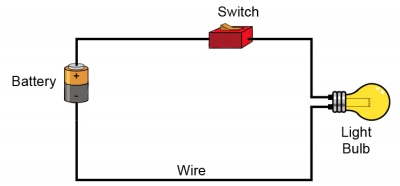
An electrical circuit is a loop around which electrical energy can move. Electricity travels from a power source, such as a battery, through wires, and back to the power source. In a simple circuit, other useful items that make use of the electricity, such as a bulb or a buzzer, are added. Electricity can only flow when there is a complete circuit.
Battery
A battery stores electrical energy and releases it when connected to a circuit. The battery will eventually run down and will have to be replaced.
Switch
A switch allows the bulb to be turned on or off without removing the battery. When the switch is closed, the circuit is complete and the bulb lights up.
Wires
Electricity flows around the circuit through a series of wires. Wires are usually made of copper, as copper is a good conductor of electricity.
Bulb
As electricity flows through the bulb, the electricity energy is converted to light energy, and the bulb glows brightly.
Conductors and Insulators
Conductors allow electricity to flow easily through them. Metals, such as copper, are good conductors of electricity. Electrical wires are made of metal so electricity can flow easily through them. Insulators do not let electricity pass through them. Plastic, rubber, and wood are good electrical insulators. Wires are coated in plastic to prevent you from getting an electric shock if you touch them.
Switching on!
Many electrical items do not need batteries as they can be plugged into the mains, using a long wire. Once they have been plugged in, these items are usually turned on by passing a switch, which completes the electrical circuit.
Picture Credit : Google

